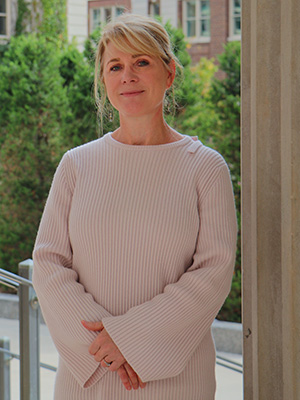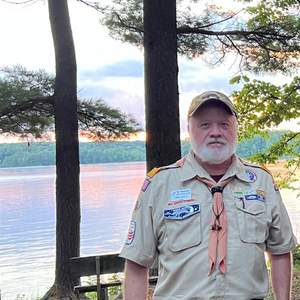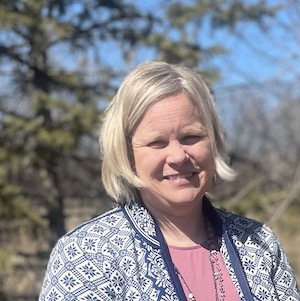Kim Moroni
Kim Moroni asks her academic advisor if, when she completes her degree, the worrisome dreams will stop. “You know—the dreams where you’re missing a test or something,” Kim says with a laugh. Her advisor assures her that graduation will bring nothing but good things, including better sleep at night.
Having started her degree decades before but being forced to put it on hold, Kim had always thought about that unfinished business of graduating and getting her diploma. Life had simply gotten in the way of that.
It’s a common enough story. Kim got married and started her family. Into the space once filled by academia, new priorities came flooding in: the pursuit of a job that would pay the bills, and the responsibility of raising four kids. Unfortunately, Kim and her first husband ended up getting a divorce, and after that, Kim’s career became more important than ever. The bachelor’s degree she’d started before her kids were born seemed like the ambition of a former self—the one who wanted to become a fine arts painter—but Kim never forgot about her desire to finish it.
“About seven years ago, I decided it was time to go back to school,” Kim says. “The timing seemed right. I started exploring the U of M’s website, and that’s how I discovered the Multidisciplinary Studies program.”
The Multidisciplinary Studies (MdS) program allows students who have been out of college for two years or more to finish the degree they started. It also encourages students to craft a degree that suits their professional interests and personal goals, emphasizing the importance of graduating with a set of skills students can put to use right away.
It was just the thing Kim was looking for. She worked with her advisor to plan a degree that would supplement her career in user design and manufacturing.
Interdisciplinary Nature of All Things
A little background about Kim: Although she didn’t complete her degree, Kim was still able to leverage her art and design skills early on to land a position in computer design for software development. Her hungry mind devoured the new skills she was being taught on the job, and eventually she earned a role she loved. Today Kim is the Director of User Experience for a software design company called PTC. Kim and her team design software for manufacturing companies. “From NASA to Harley Davidson,” she says. “We build the software these manufacturers use to support the life cycle of making and servicing products.”
Now fast forward to Kim’s first meeting with her academic advisor for the MdS program. As Kim is waiting for her appointment, she happens to pick up a brochure for another degree program, Manufacturing Operations Management. “I thought to myself, this is exactly what I want to study,” she recalls.
She asked her advisor about the manufacturing coursework, explaining that it would complement her current job, and Kim learned that she could devote an entire academic focus within her degree to manufacturing operations management. The rest of the courses she chose would satisfy two additional areas of focus: arts and humanities, and history/social science. Together, Kim and her advisor mapped out a plan for her to finish her degree, satisfying all necessary academic requirements, and doing so at a pace that felt comfortable to her.
“I started the MdS program seven years ago, taking one class per semester,” Kim says. “So, it’s taking me awhile to finish my degree, but I’m very close now. I only have three classes left.”
“Getting my degree has always been a personal thing that I wanted to accomplish. I always knew I could do it. I’m glad I’m doing it now.”
Kim explains that going back to school as a working adult is a completely different experience compared to, say, that which her kids have had as twenty-somethings. “I thought that just by getting older I was getting smarter,” Kim says with a laugh. “I figured school would be easier for me—I was wrong! Fortunately, during my first year of MdS, my instructors brought me back to the world of academics.”
That world was everything Kim was looking for, and she found that the manufacturing courses (e.g., Manufacturing for a Global Economy and Sustainable Lean Manufacturing) were making her a better researcher, strategist, and designer at her day job. The synergy between work and school made balancing the two that much easier.
Earning a Degree She Can Use
The Internet of Things and smart devices are integral to Kim’s job. She explains that the world of technology in manufacturing is changing at about the same pace that your iPhone does, so it’s important to stay on top of it. For this reason, Kim appreciated that the instructors in her manufacturing courses were professionals who work full-time in the manufacturing industry, able to provide insights on the rapid pace at which manufacturing is evolving.
“My bread and butter has everything to do with smart connected operations,” Kim says. “For me to be able to learn fundamentals and cutting edge developments in the manufacturing industry in class really gives me a leg up in my day job.”
Now that she’s almost finished with her degree, Kim says that she’s excited to finally achieve this long-standing accomplishment. The worrisome dreams about a half-done degree will come to a halt, and Kim will be able to frame and mount the bachelor’s degree she’s been thinking about for more than 30 years.
“Getting my degree has always been a personal thing that I wanted to accomplish,” says Kim. “I always knew I could do it. I’m glad I’m doing it now.”










